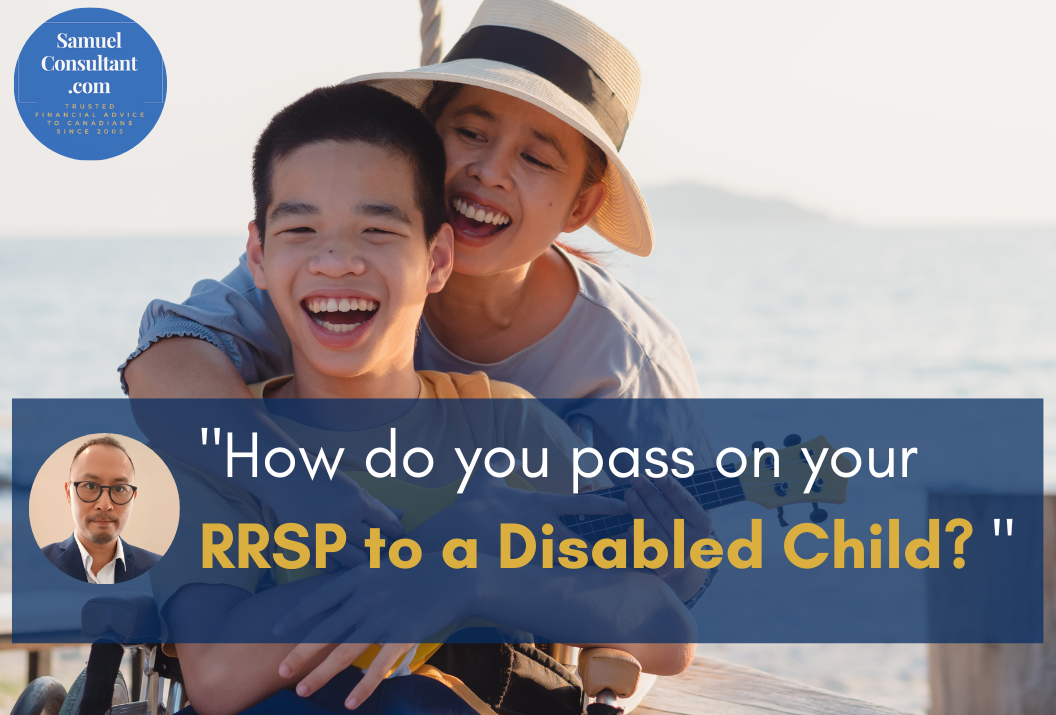I work with many parents with disabled children. One of the questions that often comes up is how the parents can transfer their assets to the disabled child when they pass away.
Many of these parents have RRSP. They would like to know the proper way to pass these assets to their disabled child.
Although there’s no single answer for every situation, I recently had a discussion with the Mackenzie Tax & Estate team and gathered some great insights on this topic.
One strategy is to roll over RRSP into the Registered Disability Savings Plan (RDSP) and here’s why.
When the parent passes away, and there is no rollover,
the entire RRSP will be taxable to the estate. This could result in HUGE tax liability, especially when there’s substantial money in the RRSP.
Also, the RRSP proceeds to the disabled beneficiary may affect their eligibility for the Ontario Disability Support Program (ODSP).
“The value of the RRSP funds will be treated as an asset and the person may then be deemed ineligible due to assets above the allowable limit.“
Quote from Ontario Disability Support Program policy directives for income support
On the other way, if the RRSP were rolled over to the RDSP.
- The rollover is tax-deferred, and it will not be taxed until money is withdrawn from the RDSP
- Protecting social assistance benefits such as ODSP as all funds held in an RDSP are fully exempt as assets.
In terms of the actual procedure, here’s what you should expect:
“When an RRSP/RRIF or RPP annuitant passes away and the funds are withdrawn from the account, a T4RSP or T4RIF is issued. This withdrawal is included on line 129 of the deceased’s final tax return. Any amount that is rolled into an RDSP is deducted on line 232.
In the RDSP beneficiary’s tax return, the rollover amount is also included on line 129, with an offsetting deduction claimed on line 232.
In order to complete the rollover process, CRA form RC4625 – Rollover to a Registered Disability Savings Plan (RDSP) Under Paragraph 60(m) must be completed.
This form is included with the tax returns of both the deceased and the beneficiary for the year of the rollover. This allows the Canada Revenue Agency (CRA) to see where the money came from and where it is going. “
Quote from Mackenzie Investments RDSP Rollover Whitepaper
Furthermore, although rolling over the RRSP into the RDSP could be an effective method for some families, there are a few things you need to keep in mind:
- The rollover can only be from a parent or grandparent to the financially dependent child or grandchild;
- The rollover is subjected to the available RDSP contribution room
- The rollover proceeds do not qualify for the matching Canada Disability Savings Grant (CDSG)
Here are a couple of Whitepapers from Mackenzie which discuss this topic more in depth:
- Are you able to rollover your Registered Plan to a Registered Disability Savings Plan (RDSP)?
- Can you roll over your registered plan to an RDSP?
As you can see, there could be lots of complex planning involved when it comes to passing your estate to a disabled family member. It is extremely important to work with an advisor with sufficient knowledge in this area so you can make an informed decision.
This is why so many families not only asked me to manage their RDSP but also consolidate their assets, such as RRSP, under our management. They prefer a more holistic approach when planning their finance and that there won’t be any gap or inconsistency due to working with different people.
Curious about whether we’re the right fit for your RDSP planning? Let’s schedule a preliminary online meeting to discuss your financial needs. This will give you a clearer understanding into our client-focused approach. To get started, just drop me an email at Samuel@SamuelConsultant.com
Disclaimer: The comments contained herein are a general discussion of certain issues intended as general information only and should not be relied upon as investment, financial, legal, accounting or tax advice. Please obtain independent professional advice, in the context of your particular circumstances.
Sources:
- Ontario Disability Support Program Policy Directives Income Support (source)
- Mackenzie Investments RDSP Rollover Whitepaper

